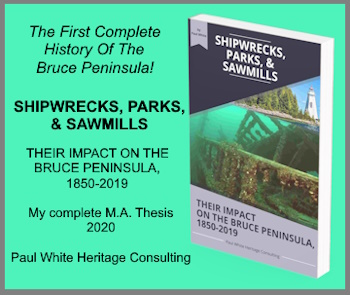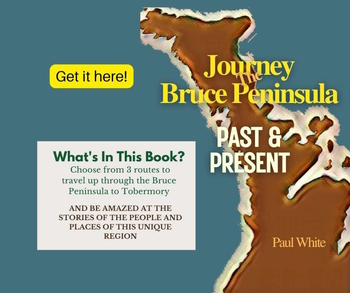Pioneer Missionary:
James Atkey
Pioneer Missionary James Atkey arrived on Colpoys Bay to minister to the native community near Oxenden until a treaty uprooted his parishioners.
The early history of the Grey and Bruce region is rich with the interesting personalities who came to this area to start a new life. The reasons why these individuals came are as diverse as their exploits after they arrived in Grey and Bruce.
In 1852 pioneer missionary, James Atkey, his wife, and their seven children, the youngest of whom was barely one and half years old, sailed from the Isle of Wight in quest of a new life in the Canadian colony.
They arrived in Montreal and after spending the winter there, the family headed for the Georgian Bay shores.
James Atkey had decided that he would dedicate his life to spreading the gospel in the Canadian wilderness. When he and his family arrived in Owen Sound, they received orders to proceed to the native reserve located on Colpoy’s Bay near the present site of the village of Oxenden.
The life of a pioneer missionary would be a new experience for the Atkey family. On the Isle of Wight James had been a been a leather and saddlery merchant. His wife and children had known a life of relative ease. Their home and clothes were of a style of the upper classes of the area. Servants maintained their home and cared for their needs.
When Atkey's business failed, he and his wife decided to make a radical change in their lifestyle and become missionaries to the Indigenous people in Canada. Little did they realize how dramatic a change they would be making!
To reach their new home the family boarded a small boat and sailed the treacherous Georgian Bay waters. But the danger of that voyage paled to what they faced when they arrived at the native community!
Apparently, according to Atkey’s recollections, the medicine man held influence in terms of "religious, medical and educational matters". A Sun Times article written in 1952 reported that "to cross him might mean death to the interlopers." After arriving at their destination, the fate of the family was in the hands of a tribal council.
After six hours of deliberation and discussion, the council decided to let them stay on the settlement and "preach and teach".
Although the Atkey family could now live and work with the Indignous people, there were still greater obstacles to overcome. They could not speak the language and the natives could not speak. or understand the English language. Therefore, communications were carried out using hand signals, body language, and facial expressions.
For his efforts as a pioneer missionary, James Atkey received $60 annual salary. To augment the family income James was forced to leave his family for extended periods working with survey crews marking roads and settlement lots.
When the natives were moved to other reserves the Atkey family remained on a farm near the former reserve. Atkey was a witness to the signing a treaty between the natives and the colonial government.
Many of James Atkey's children remained in Grey County and established lives for themselves and their descendants. Others moved to western Canada.
The story of pioneer missionary James Atkey and his family is another example of the fortitude and ingenuity of the settlers who came to build a life in Grey and Bruce counties.
The information used in this article came from files held in the Grey County Archives.
A version of this article originally appeared in my Local History column in the Owen Sound Sun Times on March 23, 2001.
Discover More About the Bruce Peninsula
Getting to the Bruce Peninsula is a relatively easy driving trip. Here are driving directions from three regions to the peninsula.
Bruce Peninsula Lumber History details the impact of the forest products industry on the development of the region.
Bruce Peninsula Lumbering provided the stimulus to develop and grow the pioneer economy on the newly settled Bruce Peninsula.
Bruce Peninsula Municipal Politics: No matter what the venue, or the issue, seldom is a popular decision made that suits everyone.
Bruce Peninsula Travel Routes were often a matter of debate because in the early years, land travel was virtually unattainable for settlers and lumbermen alike.
Bruce Peninsula winters could be difficult, especially in pioneer times when transportation connections were limited to only a few months each year.
Colpoys Bay Vista - Awesome! A short drive from either Wiarton or Owen Sound is one of the most magnificent views to be found in the province of Ontario!
Forest Products on the Bruce Peninsula contributed greatly to the growth and development of that region of the province of Ontario.
Gillies Lake: aka Ghost Lake has a mysterious past as its original name, Ghost Lake, implies.
Great Grey Owls on the Bruce Peninsula was a surprise discovery for ornithologists and others. Sadly, the story of their visit had an unfortunate conclusion.
Pioneer Campers: Hope Bay mostly considered the peninsula untamed wilderness and some of the locals were not about to disappoint them!
Pioneer Missionary James Atkey arrived on Colpoys Bay to minister to the native community near Oxenden until a treaty uprooted his parishioners.
Pioneer tourists first visited the Bruce Peninsula in the 1800s and the region continues as a great recreational and tourism destination today!
Pioneer Vacations on the Bruce Peninsula got an eerie start in the Hope Bay region of the peninsula.
Lighthouses Lighthouses were vital to Georgian Bay Sailing.
A Flowerpot Island cruise is not only entertaining, but it is also very educational as you will see things that you have never viewed before!
Travel the Bruce: Owen Sound to Wiarton A wonderful journey from Owen Sound to Wiarton.
Travel the Bruce: Wiarton to Tobermory Relaxing and historic journey.
Bruce Peninsula The Bruce Peninsula is a compelling place, with a rich history, to visit. Once you have traveled there, we guarantee that you will return, again and again!





